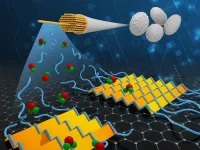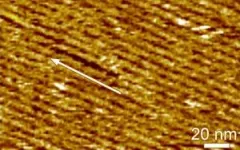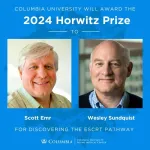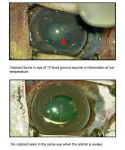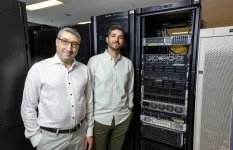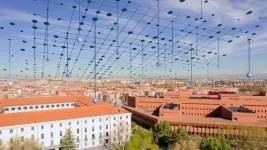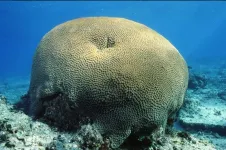(Press-News.org) RICHLAND, Wash.—After thousands of years as a highly valuable commodity, silk continues to surprise. Now it may help usher in a whole new direction for microelectronics and computing.
While silk protein has been deployed in designer electronics, its use is currently limited in part because silk fibers are a messy tangle of spaghetti-like strands.
Now, a research team led by scientists at the Department of Energy’s Pacific Northwest National Laboratory has tamed the tangle. They report in the journal Science Advances that they have achieved a uniform two-dimensional (2D) layer of silk protein fragments, or “fibroins,” on graphene, a carbon-based material useful for its excellent electrical conductivity.
“These results provide a reproducible method for silk protein self-assembly that is essential for designing and fabricating silk-based electronics,” said Chenyang Shi, the study’s lead author. “It’s important to note that this system is nontoxic and water-based, which is crucial for biocompatibility.”
This combination of materials—silk-on-graphene—could form a sensitive, tunable transistor highly desired by the microelectronics industry for wearable and implantable health sensors. The PNNL team also sees potential for their use as a key component of memory transistors or “memristors,” in computing neural networks. Memristors, used in neural networks, allow computers to mimic how the human brain functions.
The Silk Road
For centuries, silkworm silk production was a closely guarded secret in China, while its fame spread through the celebrated Silk Road trade routes to India, the Middle East, and eventually Europe. By the Middle Ages, silk had become a status symbol and a coveted commodity in European markets. Even today, silk is associated with luxury and status.
The same underlying properties that make silk fabric world-renowned—elasticity, durability, and strength—have led to its use in advanced materials applications.
“There's been a lot of research using silk as a way of modulating electronic signals, but because silk proteins are naturally disordered, there’s only so much control that’s been possible,” said James De Yoreo, a Battelle Fellow at PNNL with a dual appointment as a Professor of Materials Science and Engineering and of Chemistry at the University of Washington. “So, with our experience in controlling material growth on surfaces, we thought ‘what if we can make a better interface?’”
To do that, the team carefully controlled the reaction conditions, adding individual silk fibers to the water-based system in a precise manner. Through precision laboratory conditions, the team achieved a highly organized 2D layer of proteins packed in precise parallel β-sheets, one of the most common protein shapes in nature. Further imaging studies and complementary theoretical calculations showed that the thin silk layer adopts a stable structure with features found in natural silk. An electronic structure at this scale—less than half the thickness of a strand of DNA—supports the miniaturization found everywhere in the bio-electronics industry.
“This type of material lends itself to what we call field effects,” said De Yoreo. “This means that it’s a transistor switch that flips on or off in response to a signal. If you add, say, an antibody to it, then when a target protein binds, you cause a transistor to switch states.”
Indeed, the researchers are planning to use this starting material and technique to create their own artificial silk with functional proteins added to it to enhance its usefulness and specificity.
This study represents the first step in controlled silk layering on functional electronic components. Key areas of future research include improving the stability and conductivity of silk-integrated circuits and exploring silk's potential in biodegradable electronics to increase the use of green chemistry in electronic manufacturing.
In addition to De Yoreo, PNNL materials scientist Shuai Zhang and Xiang Yang Liu of Xiamen University, Xiamen, China, were co-lead authors of the study. Other contributors include Marlo Zorman of the University of Washington, Seattle; Xiao Zhao and Miquel B. Salmeron of Lawrence Berkeley National Laboratory; and Jim Pfaendtner of North Carolina State University.
This study was supported by the DOE Office of Science, Basic Energy Sciences program. The molecular dynamics simulations and scanning Kelvin probe microscopy measurements were supported by the DOE BES Energy Frontiers Research Centers program through CSSAS: The Center for the Sciences of Synthesis Across Scales at the University of Washington.
END
Flexible circuits made with silk and graphene on the horizon
By controlling silk protein nanostructure for the first time, scientists at PNNL pave the way for advanced microelectronic and computing applications
2024-09-18
ELSE PRESS RELEASES FROM THIS DATE:
Scott Emr and Wesley Sundquist awarded 2024 Horwitz Prize for discovering the ESCRT pathway
2024-09-18
NEW YORK, NY (September 18, 2024)—Columbia University will award the 2024 Louisa Gross Horwitz Prize to Scott Emr and Wesley Sundquist for discovering the ESCRT (Endosomal Sorting Complexes Required for Transport) pathway and revealing how it works.
ESCRT (pronounced “escort”) complexes deform the cell membrane and bend parts of it away from the cytoplasm, the space that houses all material inside a cell. This unique process plays an essential role in keeping cells healthy by packaging and sorting molecules, removing waste, and regulating important functions such as cell division, neuron remodeling, ...
Versatile knee exo for safer lifting
2024-09-18
Images
A set of knee exoskeletons, built with commercially available knee braces and drone motors at the University of Michigan, has been shown to help counteract fatigue in lifting and carrying tasks. They helped users maintain better lifting posture even when tired, a key factor in defending against on-the-job injuries, the researchers say.
"Rather than directly bracing the back and giving up on proper lifting form, we strengthen the legs to maintain it," said Robert Gregg, U-M professor of robotics and corresponding author of the study in Science Robotics. "This differs from what's more commonly done in industry."
Already ...
NIH-led studies point to potential development of a cataract drug
2024-09-18
Researchers at the National Institutes of Health (NIH) and their collaborators have identified a protein, known as RNF114, that reverses cataracts, a clouding of the eye’s lens that occurs commonly in people as they age. The study, which was conducted in the 13-lined ground squirrel and rats, may represent a possible surgery-free strategy for managing cataracts, a common cause of vision loss. The study published in the Journal of Clinical Investigation.
“Scientists have long searched for an alternative to cataract surgery, which is effective, but not without risk. Lack of access to cataract surgery is a barrier to care in some ...
Artificial intelligence grunt work can be outsourced using a new blockchain-based framework developed by Concordians
2024-09-18
Tomorrow’s workplace will be run on mind-boggling amounts of data. To make sense of it all, businesses, developers and individuals will need better artificial intelligence (AI) systems, better trained AI workers and more efficient number-crunching servers.
While big tech companies have the resources and expertise to meet these demands, they remain beyond the reach of most small and medium-sized enterprises and individuals. To respond to this need, a Concordia-led international team of researchers has developed a new framework to make complex AI tasks more accessible ...
Mental health challenges faced by children with cystic fibrosis are the focus of a major, multisite study led by UB
2024-09-18
BUFFALO, N.Y. — A University at Buffalo psychiatrist who has played a critical role in getting mental health screening and treatment integrated into routine care for adults and adolescents with cystic fibrosis (CF) has been awarded $3 million from the Cystic Fibrosis Foundation to focus on the mental health of children with the disease.
Led by UB and launched this summer, the new study is an outgrowth of The International Depression Epidemiological Study (TIDES), which began in 2014 and was the largest study of mental health in adolescents and adults with CF. As a result of TIDES, ...
UC3M and Universia obtain an ENIA Chair in artificial intelligence in data economy
2024-09-18
The Universidad Carlos III de Madrid (UC3M) is one of 22 institutions that have been selected by the Ministry for Digital Transformation and the Civil Service to create an ENIA Chair to further the development of artificial intelligence (AI)-based applications. The AImpulsa UC3M-Universia Chair, as it is called, will be the only one of its kind in Spain in the area of Data Economy and will collaborate with Universia-Banco Santander, through Santander Universities.
The ENIA Chairs' objectives, which depend on the Secretary of State for Digitalisation and Artificial Intelligence of the Ministry for Digital Transformation and ...
Why petting your cat leads to static electricity
2024-09-18
Anyone who has ever pet a cat or shuffled their feet across the carpet knows that rubbing objects together generates static electricity. But an explanation for this phenomenon has eluded researchers for more than two millennia.
Now, Northwestern University scientists have finally uncovered the mechanics at play.
When an object slides, the front and back parts of that object experience different forces, researchers found. This difference in forces causes different electrical charges to build up on the front and back parts of the object. And the difference in electrical charges creates a current, leading to a light zap.
The study was published yesterday (Sept. 17) in the journal ...
UC San Diego Health maintains top quality care status by Vizient
2024-09-18
UC San Diego Health has been honored as a top performer for Vizient’s 2024 Bernard A. Birnbaum, MD, Quality Leadership Performance Award, marking the sixth consecutive year the health system has achieved this prominent distinction. This award places UC San Diego Health among the top academic medical centers in the nation, highlighting its exceptional commitment to delivering high-quality, patient-centered care. This sustained excellence recognizes the region’s only academic medical center’s mission of advancing health care standards and outcomes at the highest level.
“Being named a Vizient top performer for the sixth year in a row underscores ...
If you build it, will they come? Wildlife corridors need smarter design
2024-09-18
As human population and development continue to expand, it’s more important than ever to set aside corridors of undeveloped land where wildlife can travel safely, helping to ensure their long-term survival. However, a recent study by the University of Maryland reveals that current methods of designing and evaluating wildlife corridors may not be adequate to ensure wildlife protection, and suggests that Best Management Practices should include analyzing corridors with a smarter and more thorough framework. University researchers tested different ...
Sea surface temperature record in the southwestern Pacific: Coral colony from Fiji reveals warmest temperatures in over 600 years
2024-09-18
The sea surface temperature in the Fijian archipelago in the southwestern Pacific is now at its maximum for more than 600 years. This is the result of an international research team's evaluation of a new coral record providing further evidence for unprecedented warming in the western Pacific Ocean. According to this, the year 2022 was the warmest year in the region since 1370. The scientists used the giant coral Diploastrea heliopora colony in Fiji to obtain the data for the new reconstruction. These unique and long-lived massive corals record long-term climatic and ...
LAST 30 PRESS RELEASES:
Numbers in our sights affect how we perceive space
SIMJ announces global collaborative book project in commemoration of its 75th anniversary
Air pollution exposure and birth weight
Obstructive sleep apnea risk and mental health conditions among older adults
How talking slows eye movements behind the wheel
The Ceramic Society of Japan’s Oxoate Ceramics Research Association launches new international book project
Heart-brain connection: international study reveals the role of the vagus nerve in keeping the heart young
Researchers identify Rb1 as a predictive biomarker for a new therapeutic strategy in some breast cancers
Survey reveals ethical gaps slowing AI adoption in pediatric surgery
Stimulant ADHD medications work differently than thought
AI overestimates how smart people are, according to HSE economists
HSE researchers create genome-wide map of quadruplexes
Scientists boost cell "powerhouses" to burn more calories
Automatic label checking: The missing step in making reliable medical AI
Low daily alcohol intake linked to 50% heightened mouth cancer risk in India
American Meteorological Society announces Rick Spinrad as 2026 President-Elect
Biomass-based carbon capture spotlighted in newly released global climate webinar recording
Illuminating invisible nano pollutants: advanced bioimaging tracks the full journey of emerging nanoscale contaminants in living systems
How does age affect recovery from spinal cord injury?
Novel AI tool offers prognosis for patients with head and neck cancer
Fathers’ microplastic exposure tied to their children’s metabolic problems
Research validates laboratory model for studying high-grade serous ovarian cancer
SIR 2026 delivers transformative breakthroughs in minimally invasive medicine to improve patient care
Stem Cell Reports most downloaded papers of 2025 highlight the breadth and impact of stem cell research
Oxford-led study estimates NHS spends around 3% of its primary and secondary care budget on the health impacts of heat and cold in England
A researcher’s long quest leads to a smart composite breakthrough
Urban wild bees act as “microbial sensors” of city health.
New study finds where you live affects recovery after a hip fracture
Forecasting the impact of fully automated vehicle adoption on US road traffic injuries
Alcohol-related hospitalizations from 2016 to 2022
[Press-News.org] Flexible circuits made with silk and graphene on the horizonBy controlling silk protein nanostructure for the first time, scientists at PNNL pave the way for advanced microelectronic and computing applications
